Health Promotion: Analyzing Mr. Mo Hong's Health and Behaviors
VerifiedAdded on 2022/11/23
|16
|4995
|381
Report
AI Summary
This report presents a comprehensive analysis of Mr. Mo Hong's health, addressing the impact of his diet, weight, lifestyle, lack of exercise, alcohol consumption, and smoking habits. It draws on evidence from literature to highlight the adverse effects of these behaviors on his health. The report includes a needs assessment focusing on Mr. Hong's concerns about bowel cancer, and it identifies the appropriate level of health promotion work. A SMART aim and two SMART objectives are formulated for a health promotion program designed to encourage him to stop smoking and attend bowel screening. Five health promotion approaches are discussed, with the behavioral change approach selected as the most suitable. The report outlines specific health promotion activities, such as education and communication, and recommends the Health Belief Model to guide the program. Ethical considerations relevant to health promotion work are also discussed. The report concludes with an evaluation of the program's utility and effectiveness, offering insights into how to improve Mr. Hong's health and well-being. The report considers the levels of health promotion work, approaches, activities, and models for Mr. Hong.
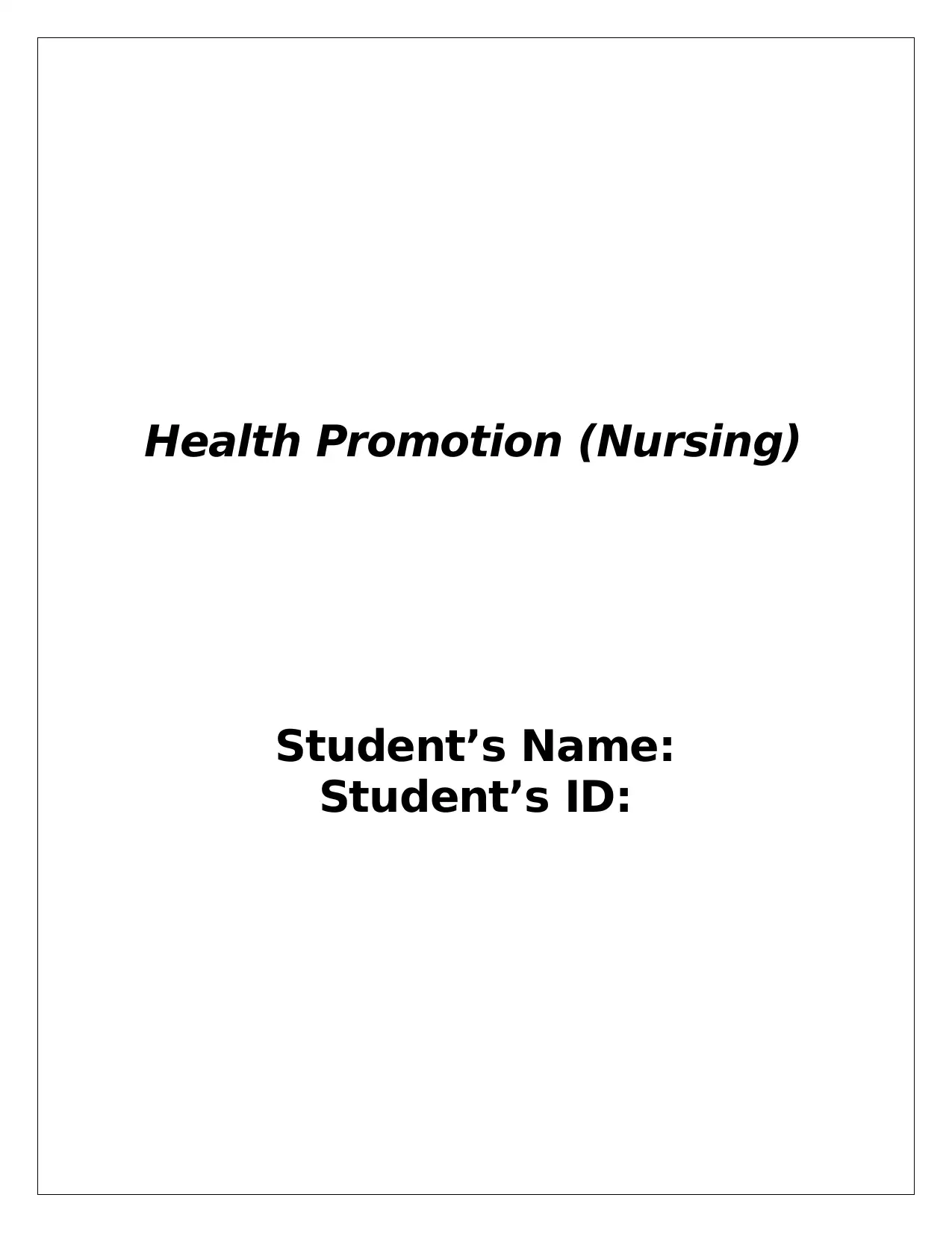
Health Promotion (Nursing)
Student’s Name:
Student’s ID:
Student’s Name:
Student’s ID:
Paraphrase This Document
Need a fresh take? Get an instant paraphrase of this document with our AI Paraphraser
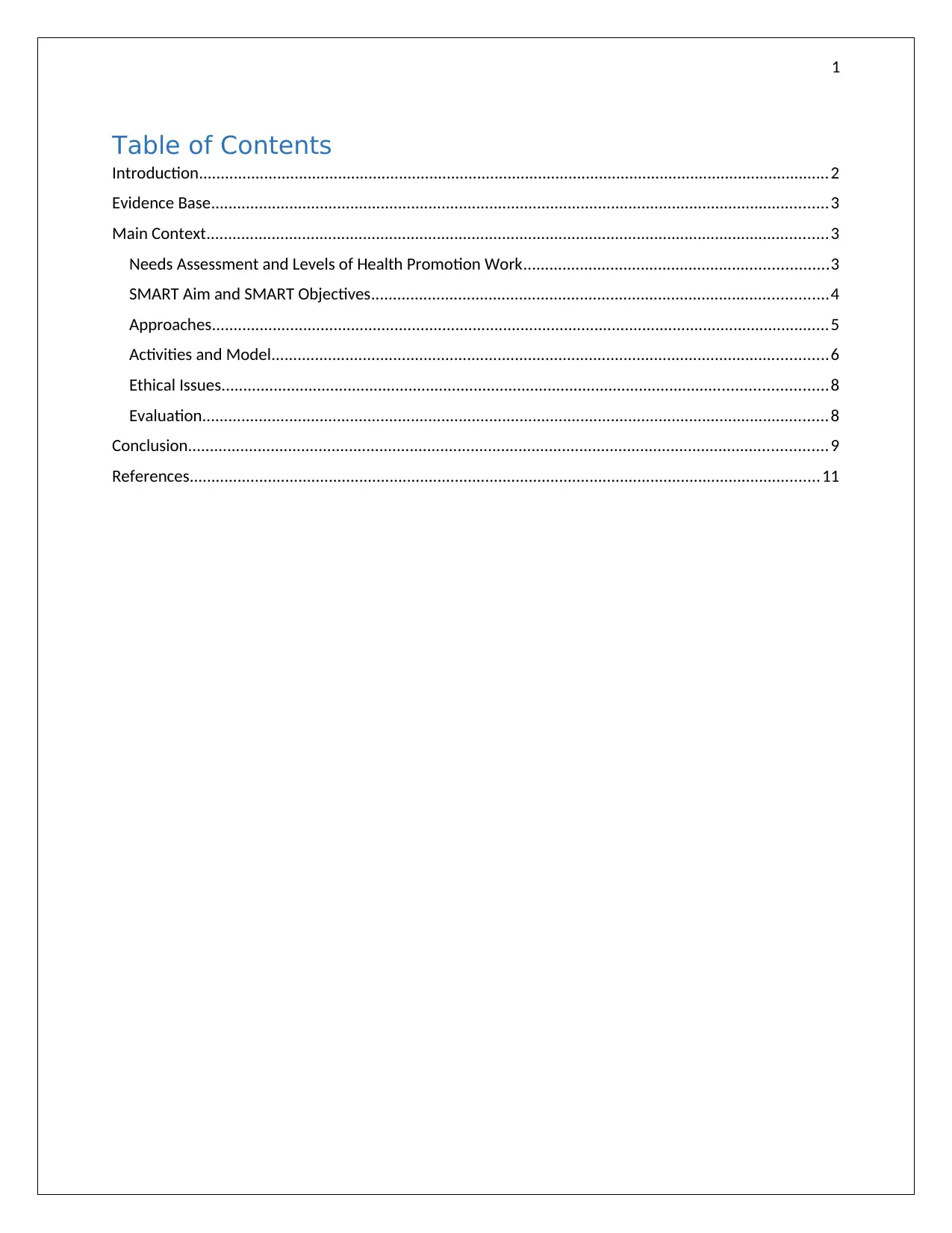
1
Table of Contents
Introduction.................................................................................................................................................2
Evidence Base..............................................................................................................................................3
Main Context...............................................................................................................................................3
Needs Assessment and Levels of Health Promotion Work......................................................................3
SMART Aim and SMART Objectives.........................................................................................................4
Approaches..............................................................................................................................................5
Activities and Model................................................................................................................................6
Ethical Issues...........................................................................................................................................8
Evaluation................................................................................................................................................8
Conclusion...................................................................................................................................................9
References.................................................................................................................................................11
Table of Contents
Introduction.................................................................................................................................................2
Evidence Base..............................................................................................................................................3
Main Context...............................................................................................................................................3
Needs Assessment and Levels of Health Promotion Work......................................................................3
SMART Aim and SMART Objectives.........................................................................................................4
Approaches..............................................................................................................................................5
Activities and Model................................................................................................................................6
Ethical Issues...........................................................................................................................................8
Evaluation................................................................................................................................................8
Conclusion...................................................................................................................................................9
References.................................................................................................................................................11
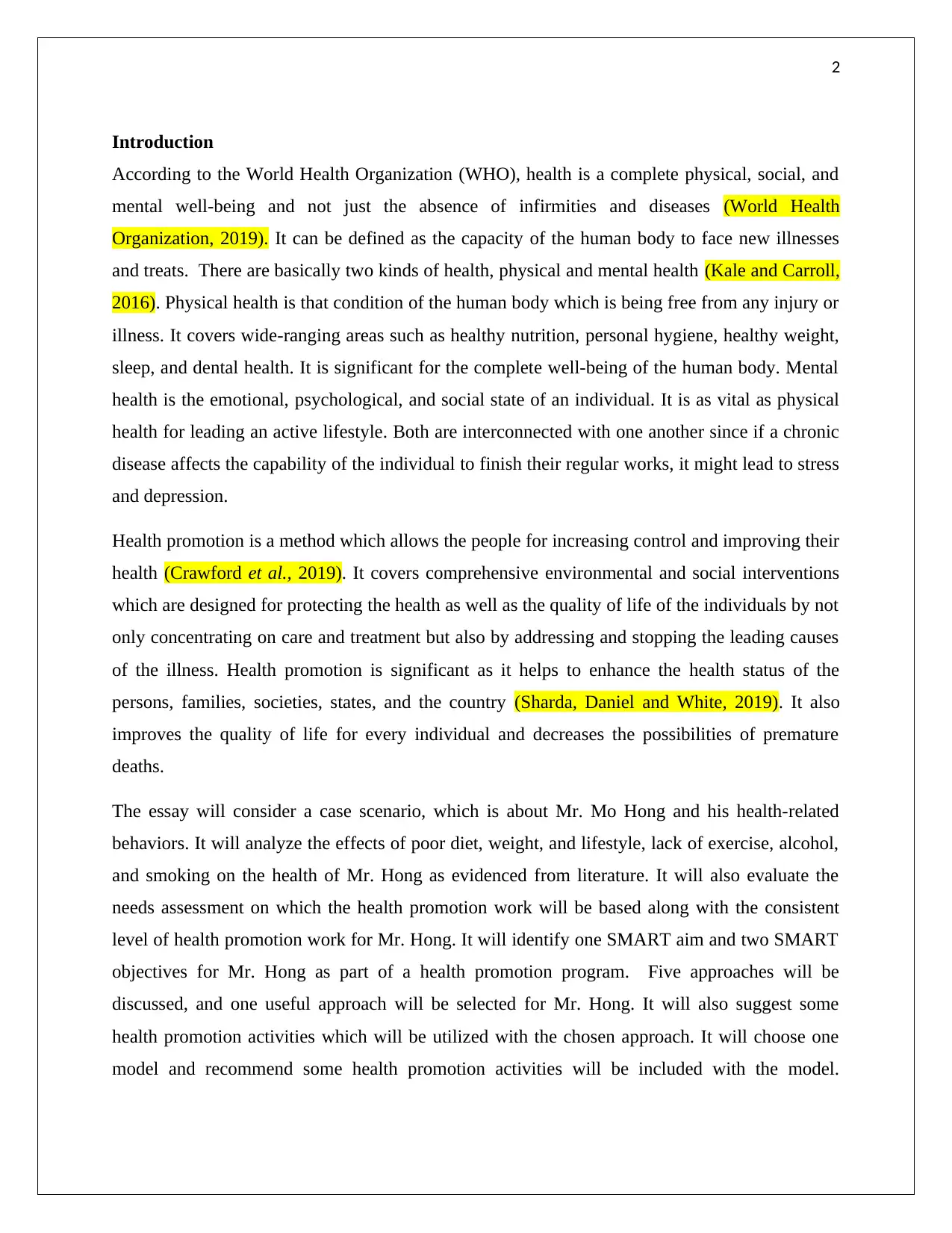
2
Introduction
According to the World Health Organization (WHO), health is a complete physical, social, and
mental well-being and not just the absence of infirmities and diseases (World Health
Organization, 2019). It can be defined as the capacity of the human body to face new illnesses
and treats. There are basically two kinds of health, physical and mental health (Kale and Carroll,
2016). Physical health is that condition of the human body which is being free from any injury or
illness. It covers wide-ranging areas such as healthy nutrition, personal hygiene, healthy weight,
sleep, and dental health. It is significant for the complete well-being of the human body. Mental
health is the emotional, psychological, and social state of an individual. It is as vital as physical
health for leading an active lifestyle. Both are interconnected with one another since if a chronic
disease affects the capability of the individual to finish their regular works, it might lead to stress
and depression.
Health promotion is a method which allows the people for increasing control and improving their
health (Crawford et al., 2019). It covers comprehensive environmental and social interventions
which are designed for protecting the health as well as the quality of life of the individuals by not
only concentrating on care and treatment but also by addressing and stopping the leading causes
of the illness. Health promotion is significant as it helps to enhance the health status of the
persons, families, societies, states, and the country (Sharda, Daniel and White, 2019). It also
improves the quality of life for every individual and decreases the possibilities of premature
deaths.
The essay will consider a case scenario, which is about Mr. Mo Hong and his health-related
behaviors. It will analyze the effects of poor diet, weight, and lifestyle, lack of exercise, alcohol,
and smoking on the health of Mr. Hong as evidenced from literature. It will also evaluate the
needs assessment on which the health promotion work will be based along with the consistent
level of health promotion work for Mr. Hong. It will identify one SMART aim and two SMART
objectives for Mr. Hong as part of a health promotion program. Five approaches will be
discussed, and one useful approach will be selected for Mr. Hong. It will also suggest some
health promotion activities which will be utilized with the chosen approach. It will choose one
model and recommend some health promotion activities will be included with the model.
Introduction
According to the World Health Organization (WHO), health is a complete physical, social, and
mental well-being and not just the absence of infirmities and diseases (World Health
Organization, 2019). It can be defined as the capacity of the human body to face new illnesses
and treats. There are basically two kinds of health, physical and mental health (Kale and Carroll,
2016). Physical health is that condition of the human body which is being free from any injury or
illness. It covers wide-ranging areas such as healthy nutrition, personal hygiene, healthy weight,
sleep, and dental health. It is significant for the complete well-being of the human body. Mental
health is the emotional, psychological, and social state of an individual. It is as vital as physical
health for leading an active lifestyle. Both are interconnected with one another since if a chronic
disease affects the capability of the individual to finish their regular works, it might lead to stress
and depression.
Health promotion is a method which allows the people for increasing control and improving their
health (Crawford et al., 2019). It covers comprehensive environmental and social interventions
which are designed for protecting the health as well as the quality of life of the individuals by not
only concentrating on care and treatment but also by addressing and stopping the leading causes
of the illness. Health promotion is significant as it helps to enhance the health status of the
persons, families, societies, states, and the country (Sharda, Daniel and White, 2019). It also
improves the quality of life for every individual and decreases the possibilities of premature
deaths.
The essay will consider a case scenario, which is about Mr. Mo Hong and his health-related
behaviors. It will analyze the effects of poor diet, weight, and lifestyle, lack of exercise, alcohol,
and smoking on the health of Mr. Hong as evidenced from literature. It will also evaluate the
needs assessment on which the health promotion work will be based along with the consistent
level of health promotion work for Mr. Hong. It will identify one SMART aim and two SMART
objectives for Mr. Hong as part of a health promotion program. Five approaches will be
discussed, and one useful approach will be selected for Mr. Hong. It will also suggest some
health promotion activities which will be utilized with the chosen approach. It will choose one
model and recommend some health promotion activities will be included with the model.
⊘ This is a preview!⊘
Do you want full access?
Subscribe today to unlock all pages.

Trusted by 1+ million students worldwide
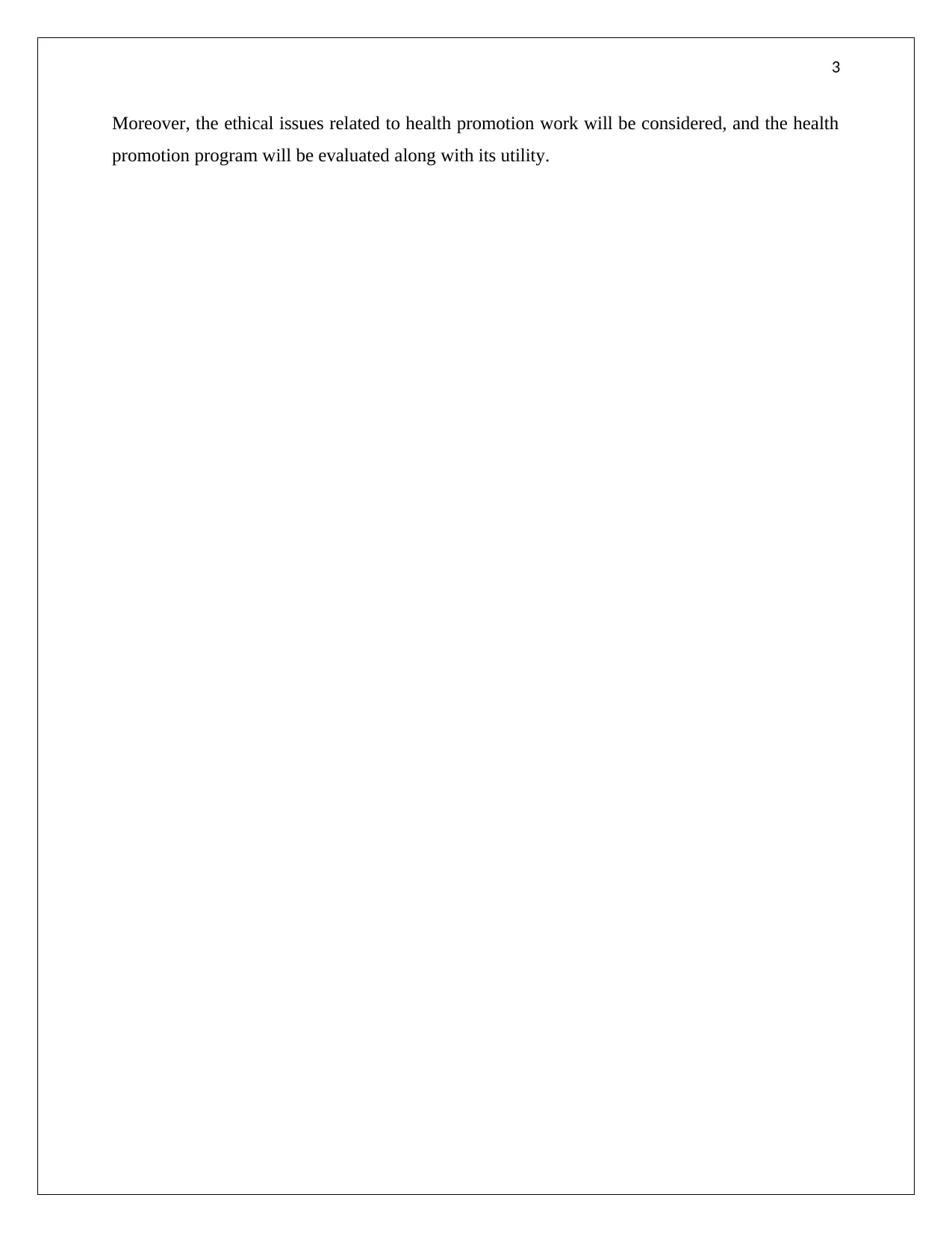
3
Moreover, the ethical issues related to health promotion work will be considered, and the health
promotion program will be evaluated along with its utility.
Moreover, the ethical issues related to health promotion work will be considered, and the health
promotion program will be evaluated along with its utility.
Paraphrase This Document
Need a fresh take? Get an instant paraphrase of this document with our AI Paraphraser
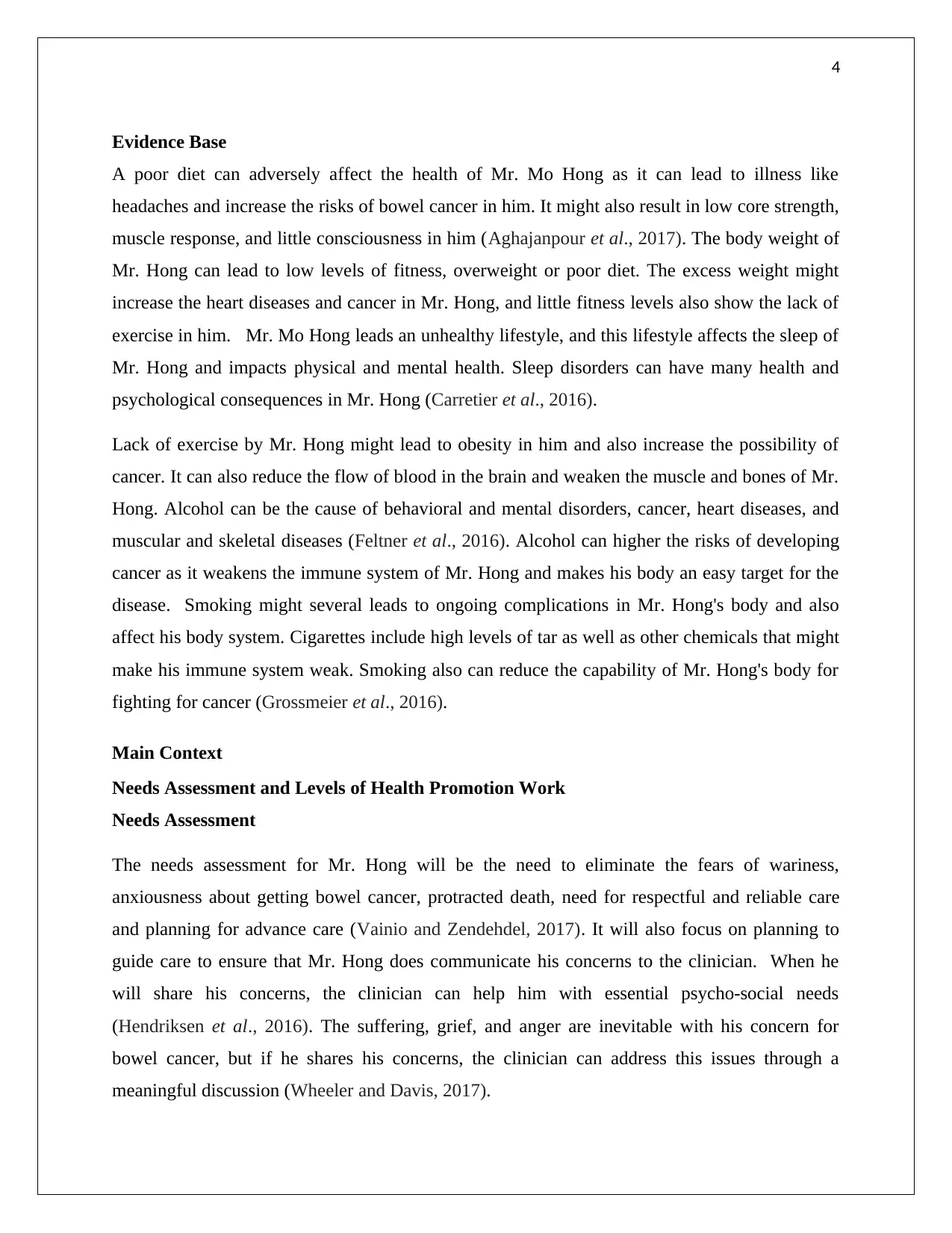
4
Evidence Base
A poor diet can adversely affect the health of Mr. Mo Hong as it can lead to illness like
headaches and increase the risks of bowel cancer in him. It might also result in low core strength,
muscle response, and little consciousness in him (Aghajanpour et al., 2017). The body weight of
Mr. Hong can lead to low levels of fitness, overweight or poor diet. The excess weight might
increase the heart diseases and cancer in Mr. Hong, and little fitness levels also show the lack of
exercise in him. Mr. Mo Hong leads an unhealthy lifestyle, and this lifestyle affects the sleep of
Mr. Hong and impacts physical and mental health. Sleep disorders can have many health and
psychological consequences in Mr. Hong (Carretier et al., 2016).
Lack of exercise by Mr. Hong might lead to obesity in him and also increase the possibility of
cancer. It can also reduce the flow of blood in the brain and weaken the muscle and bones of Mr.
Hong. Alcohol can be the cause of behavioral and mental disorders, cancer, heart diseases, and
muscular and skeletal diseases (Feltner et al., 2016). Alcohol can higher the risks of developing
cancer as it weakens the immune system of Mr. Hong and makes his body an easy target for the
disease. Smoking might several leads to ongoing complications in Mr. Hong's body and also
affect his body system. Cigarettes include high levels of tar as well as other chemicals that might
make his immune system weak. Smoking also can reduce the capability of Mr. Hong's body for
fighting for cancer (Grossmeier et al., 2016).
Main Context
Needs Assessment and Levels of Health Promotion Work
Needs Assessment
The needs assessment for Mr. Hong will be the need to eliminate the fears of wariness,
anxiousness about getting bowel cancer, protracted death, need for respectful and reliable care
and planning for advance care (Vainio and Zendehdel, 2017). It will also focus on planning to
guide care to ensure that Mr. Hong does communicate his concerns to the clinician. When he
will share his concerns, the clinician can help him with essential psycho-social needs
(Hendriksen et al., 2016). The suffering, grief, and anger are inevitable with his concern for
bowel cancer, but if he shares his concerns, the clinician can address this issues through a
meaningful discussion (Wheeler and Davis, 2017).
Evidence Base
A poor diet can adversely affect the health of Mr. Mo Hong as it can lead to illness like
headaches and increase the risks of bowel cancer in him. It might also result in low core strength,
muscle response, and little consciousness in him (Aghajanpour et al., 2017). The body weight of
Mr. Hong can lead to low levels of fitness, overweight or poor diet. The excess weight might
increase the heart diseases and cancer in Mr. Hong, and little fitness levels also show the lack of
exercise in him. Mr. Mo Hong leads an unhealthy lifestyle, and this lifestyle affects the sleep of
Mr. Hong and impacts physical and mental health. Sleep disorders can have many health and
psychological consequences in Mr. Hong (Carretier et al., 2016).
Lack of exercise by Mr. Hong might lead to obesity in him and also increase the possibility of
cancer. It can also reduce the flow of blood in the brain and weaken the muscle and bones of Mr.
Hong. Alcohol can be the cause of behavioral and mental disorders, cancer, heart diseases, and
muscular and skeletal diseases (Feltner et al., 2016). Alcohol can higher the risks of developing
cancer as it weakens the immune system of Mr. Hong and makes his body an easy target for the
disease. Smoking might several leads to ongoing complications in Mr. Hong's body and also
affect his body system. Cigarettes include high levels of tar as well as other chemicals that might
make his immune system weak. Smoking also can reduce the capability of Mr. Hong's body for
fighting for cancer (Grossmeier et al., 2016).
Main Context
Needs Assessment and Levels of Health Promotion Work
Needs Assessment
The needs assessment for Mr. Hong will be the need to eliminate the fears of wariness,
anxiousness about getting bowel cancer, protracted death, need for respectful and reliable care
and planning for advance care (Vainio and Zendehdel, 2017). It will also focus on planning to
guide care to ensure that Mr. Hong does communicate his concerns to the clinician. When he
will share his concerns, the clinician can help him with essential psycho-social needs
(Hendriksen et al., 2016). The suffering, grief, and anger are inevitable with his concern for
bowel cancer, but if he shares his concerns, the clinician can address this issues through a
meaningful discussion (Wheeler and Davis, 2017).
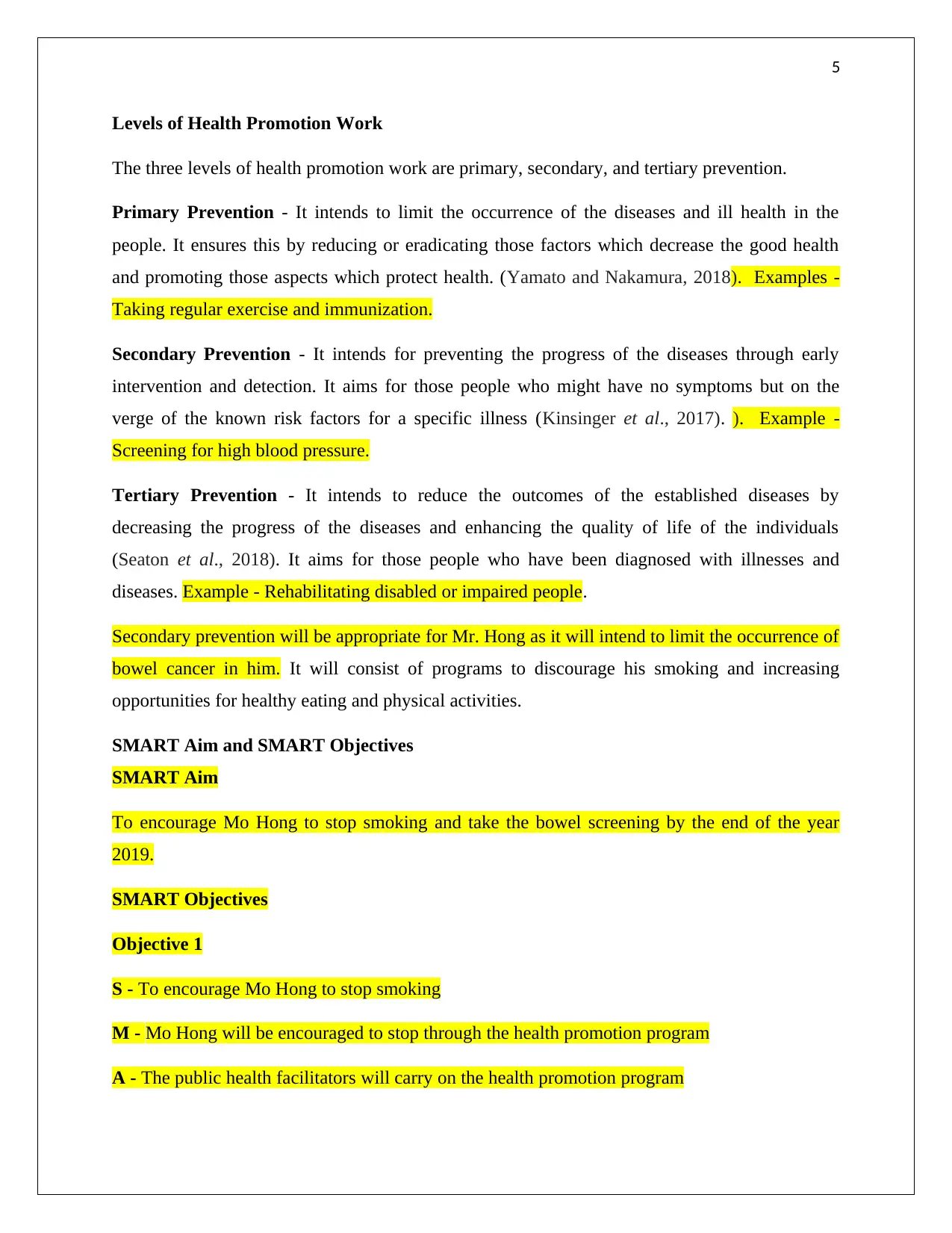
5
Levels of Health Promotion Work
The three levels of health promotion work are primary, secondary, and tertiary prevention.
Primary Prevention - It intends to limit the occurrence of the diseases and ill health in the
people. It ensures this by reducing or eradicating those factors which decrease the good health
and promoting those aspects which protect health. (Yamato and Nakamura, 2018). Examples -
Taking regular exercise and immunization.
Secondary Prevention - It intends for preventing the progress of the diseases through early
intervention and detection. It aims for those people who might have no symptoms but on the
verge of the known risk factors for a specific illness (Kinsinger et al., 2017). ). Example -
Screening for high blood pressure.
Tertiary Prevention - It intends to reduce the outcomes of the established diseases by
decreasing the progress of the diseases and enhancing the quality of life of the individuals
(Seaton et al., 2018). It aims for those people who have been diagnosed with illnesses and
diseases. Example - Rehabilitating disabled or impaired people.
Secondary prevention will be appropriate for Mr. Hong as it will intend to limit the occurrence of
bowel cancer in him. It will consist of programs to discourage his smoking and increasing
opportunities for healthy eating and physical activities.
SMART Aim and SMART Objectives
SMART Aim
To encourage Mo Hong to stop smoking and take the bowel screening by the end of the year
2019.
SMART Objectives
Objective 1
S - To encourage Mo Hong to stop smoking
M - Mo Hong will be encouraged to stop through the health promotion program
A - The public health facilitators will carry on the health promotion program
Levels of Health Promotion Work
The three levels of health promotion work are primary, secondary, and tertiary prevention.
Primary Prevention - It intends to limit the occurrence of the diseases and ill health in the
people. It ensures this by reducing or eradicating those factors which decrease the good health
and promoting those aspects which protect health. (Yamato and Nakamura, 2018). Examples -
Taking regular exercise and immunization.
Secondary Prevention - It intends for preventing the progress of the diseases through early
intervention and detection. It aims for those people who might have no symptoms but on the
verge of the known risk factors for a specific illness (Kinsinger et al., 2017). ). Example -
Screening for high blood pressure.
Tertiary Prevention - It intends to reduce the outcomes of the established diseases by
decreasing the progress of the diseases and enhancing the quality of life of the individuals
(Seaton et al., 2018). It aims for those people who have been diagnosed with illnesses and
diseases. Example - Rehabilitating disabled or impaired people.
Secondary prevention will be appropriate for Mr. Hong as it will intend to limit the occurrence of
bowel cancer in him. It will consist of programs to discourage his smoking and increasing
opportunities for healthy eating and physical activities.
SMART Aim and SMART Objectives
SMART Aim
To encourage Mo Hong to stop smoking and take the bowel screening by the end of the year
2019.
SMART Objectives
Objective 1
S - To encourage Mo Hong to stop smoking
M - Mo Hong will be encouraged to stop through the health promotion program
A - The public health facilitators will carry on the health promotion program
⊘ This is a preview!⊘
Do you want full access?
Subscribe today to unlock all pages.

Trusted by 1+ million students worldwide
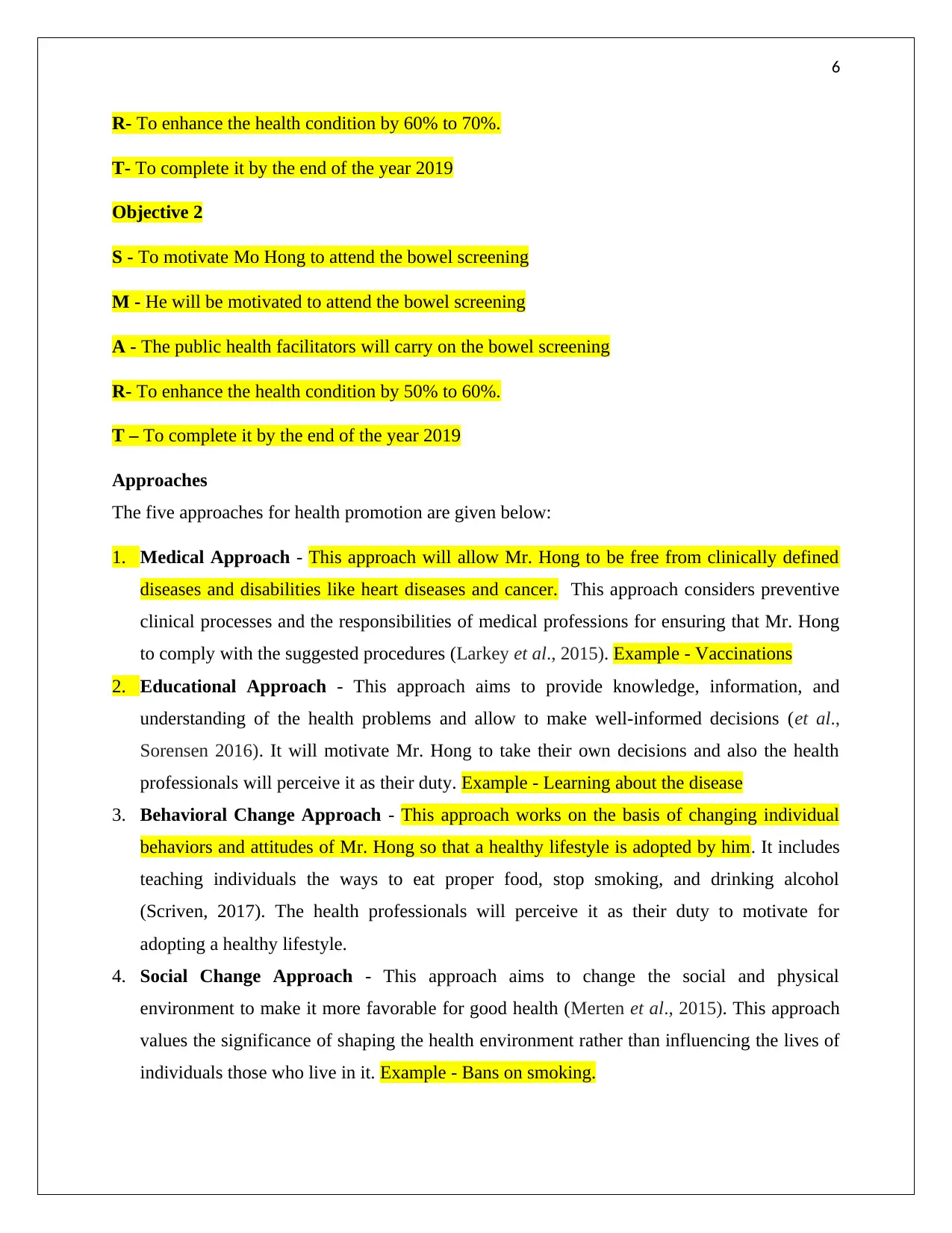
6
R- To enhance the health condition by 60% to 70%.
T- To complete it by the end of the year 2019
Objective 2
S - To motivate Mo Hong to attend the bowel screening
M - He will be motivated to attend the bowel screening
A - The public health facilitators will carry on the bowel screening
R- To enhance the health condition by 50% to 60%.
T – To complete it by the end of the year 2019
Approaches
The five approaches for health promotion are given below:
1. Medical Approach - This approach will allow Mr. Hong to be free from clinically defined
diseases and disabilities like heart diseases and cancer. This approach considers preventive
clinical processes and the responsibilities of medical professions for ensuring that Mr. Hong
to comply with the suggested procedures (Larkey et al., 2015). Example - Vaccinations
2. Educational Approach - This approach aims to provide knowledge, information, and
understanding of the health problems and allow to make well-informed decisions (et al.,
Sorensen 2016). It will motivate Mr. Hong to take their own decisions and also the health
professionals will perceive it as their duty. Example - Learning about the disease
3. Behavioral Change Approach - This approach works on the basis of changing individual
behaviors and attitudes of Mr. Hong so that a healthy lifestyle is adopted by him. It includes
teaching individuals the ways to eat proper food, stop smoking, and drinking alcohol
(Scriven, 2017). The health professionals will perceive it as their duty to motivate for
adopting a healthy lifestyle.
4. Social Change Approach - This approach aims to change the social and physical
environment to make it more favorable for good health (Merten et al., 2015). This approach
values the significance of shaping the health environment rather than influencing the lives of
individuals those who live in it. Example - Bans on smoking.
R- To enhance the health condition by 60% to 70%.
T- To complete it by the end of the year 2019
Objective 2
S - To motivate Mo Hong to attend the bowel screening
M - He will be motivated to attend the bowel screening
A - The public health facilitators will carry on the bowel screening
R- To enhance the health condition by 50% to 60%.
T – To complete it by the end of the year 2019
Approaches
The five approaches for health promotion are given below:
1. Medical Approach - This approach will allow Mr. Hong to be free from clinically defined
diseases and disabilities like heart diseases and cancer. This approach considers preventive
clinical processes and the responsibilities of medical professions for ensuring that Mr. Hong
to comply with the suggested procedures (Larkey et al., 2015). Example - Vaccinations
2. Educational Approach - This approach aims to provide knowledge, information, and
understanding of the health problems and allow to make well-informed decisions (et al.,
Sorensen 2016). It will motivate Mr. Hong to take their own decisions and also the health
professionals will perceive it as their duty. Example - Learning about the disease
3. Behavioral Change Approach - This approach works on the basis of changing individual
behaviors and attitudes of Mr. Hong so that a healthy lifestyle is adopted by him. It includes
teaching individuals the ways to eat proper food, stop smoking, and drinking alcohol
(Scriven, 2017). The health professionals will perceive it as their duty to motivate for
adopting a healthy lifestyle.
4. Social Change Approach - This approach aims to change the social and physical
environment to make it more favorable for good health (Merten et al., 2015). This approach
values the significance of shaping the health environment rather than influencing the lives of
individuals those who live in it. Example - Bans on smoking.
Paraphrase This Document
Need a fresh take? Get an instant paraphrase of this document with our AI Paraphraser
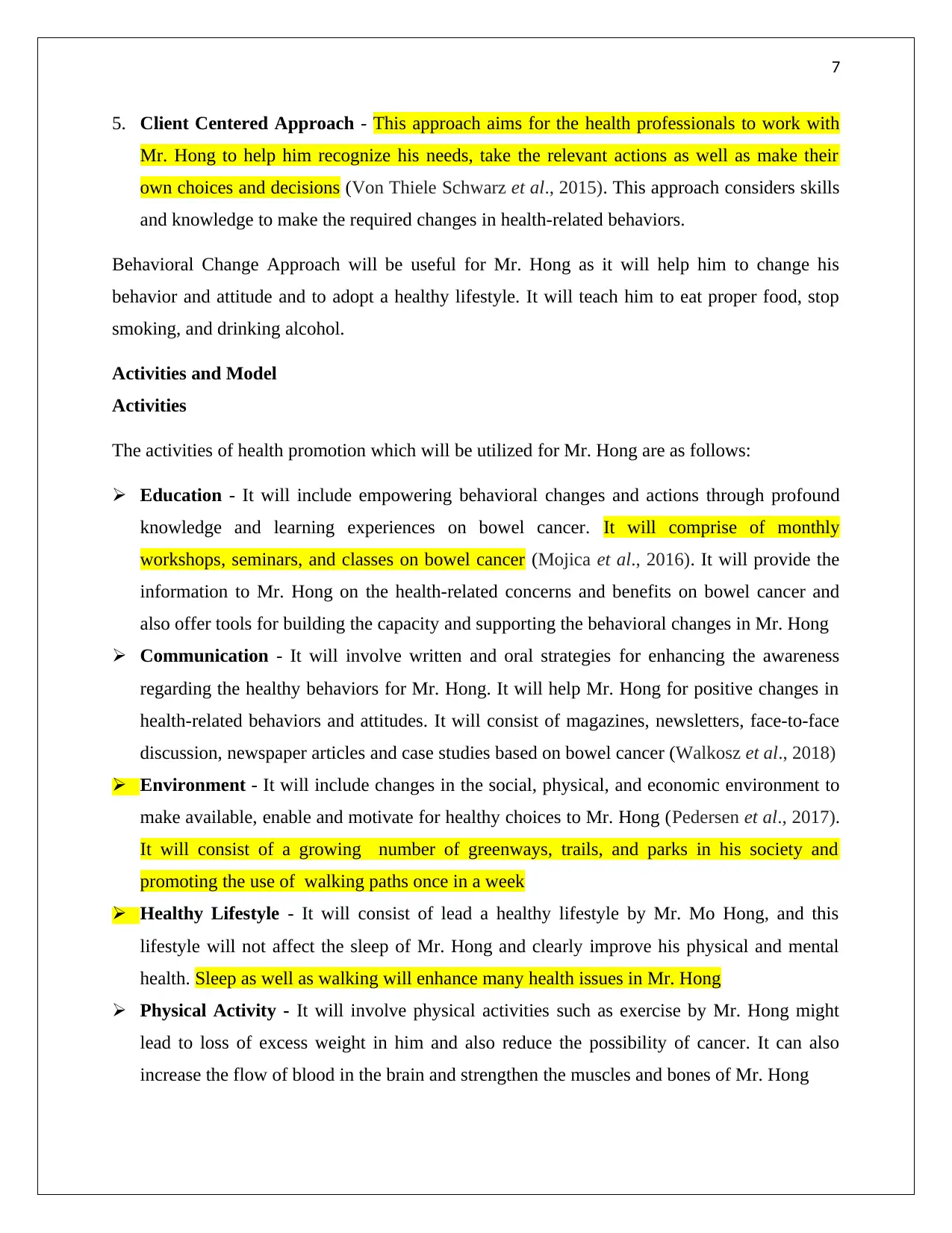
7
5. Client Centered Approach - This approach aims for the health professionals to work with
Mr. Hong to help him recognize his needs, take the relevant actions as well as make their
own choices and decisions (Von Thiele Schwarz et al., 2015). This approach considers skills
and knowledge to make the required changes in health-related behaviors.
Behavioral Change Approach will be useful for Mr. Hong as it will help him to change his
behavior and attitude and to adopt a healthy lifestyle. It will teach him to eat proper food, stop
smoking, and drinking alcohol.
Activities and Model
Activities
The activities of health promotion which will be utilized for Mr. Hong are as follows:
Education - It will include empowering behavioral changes and actions through profound
knowledge and learning experiences on bowel cancer. It will comprise of monthly
workshops, seminars, and classes on bowel cancer (Mojica et al., 2016). It will provide the
information to Mr. Hong on the health-related concerns and benefits on bowel cancer and
also offer tools for building the capacity and supporting the behavioral changes in Mr. Hong
Communication - It will involve written and oral strategies for enhancing the awareness
regarding the healthy behaviors for Mr. Hong. It will help Mr. Hong for positive changes in
health-related behaviors and attitudes. It will consist of magazines, newsletters, face-to-face
discussion, newspaper articles and case studies based on bowel cancer (Walkosz et al., 2018)
Environment - It will include changes in the social, physical, and economic environment to
make available, enable and motivate for healthy choices to Mr. Hong (Pedersen et al., 2017).
It will consist of a growing number of greenways, trails, and parks in his society and
promoting the use of walking paths once in a week
Healthy Lifestyle - It will consist of lead a healthy lifestyle by Mr. Mo Hong, and this
lifestyle will not affect the sleep of Mr. Hong and clearly improve his physical and mental
health. Sleep as well as walking will enhance many health issues in Mr. Hong
Physical Activity - It will involve physical activities such as exercise by Mr. Hong might
lead to loss of excess weight in him and also reduce the possibility of cancer. It can also
increase the flow of blood in the brain and strengthen the muscles and bones of Mr. Hong
5. Client Centered Approach - This approach aims for the health professionals to work with
Mr. Hong to help him recognize his needs, take the relevant actions as well as make their
own choices and decisions (Von Thiele Schwarz et al., 2015). This approach considers skills
and knowledge to make the required changes in health-related behaviors.
Behavioral Change Approach will be useful for Mr. Hong as it will help him to change his
behavior and attitude and to adopt a healthy lifestyle. It will teach him to eat proper food, stop
smoking, and drinking alcohol.
Activities and Model
Activities
The activities of health promotion which will be utilized for Mr. Hong are as follows:
Education - It will include empowering behavioral changes and actions through profound
knowledge and learning experiences on bowel cancer. It will comprise of monthly
workshops, seminars, and classes on bowel cancer (Mojica et al., 2016). It will provide the
information to Mr. Hong on the health-related concerns and benefits on bowel cancer and
also offer tools for building the capacity and supporting the behavioral changes in Mr. Hong
Communication - It will involve written and oral strategies for enhancing the awareness
regarding the healthy behaviors for Mr. Hong. It will help Mr. Hong for positive changes in
health-related behaviors and attitudes. It will consist of magazines, newsletters, face-to-face
discussion, newspaper articles and case studies based on bowel cancer (Walkosz et al., 2018)
Environment - It will include changes in the social, physical, and economic environment to
make available, enable and motivate for healthy choices to Mr. Hong (Pedersen et al., 2017).
It will consist of a growing number of greenways, trails, and parks in his society and
promoting the use of walking paths once in a week
Healthy Lifestyle - It will consist of lead a healthy lifestyle by Mr. Mo Hong, and this
lifestyle will not affect the sleep of Mr. Hong and clearly improve his physical and mental
health. Sleep as well as walking will enhance many health issues in Mr. Hong
Physical Activity - It will involve physical activities such as exercise by Mr. Hong might
lead to loss of excess weight in him and also reduce the possibility of cancer. It can also
increase the flow of blood in the brain and strengthen the muscles and bones of Mr. Hong
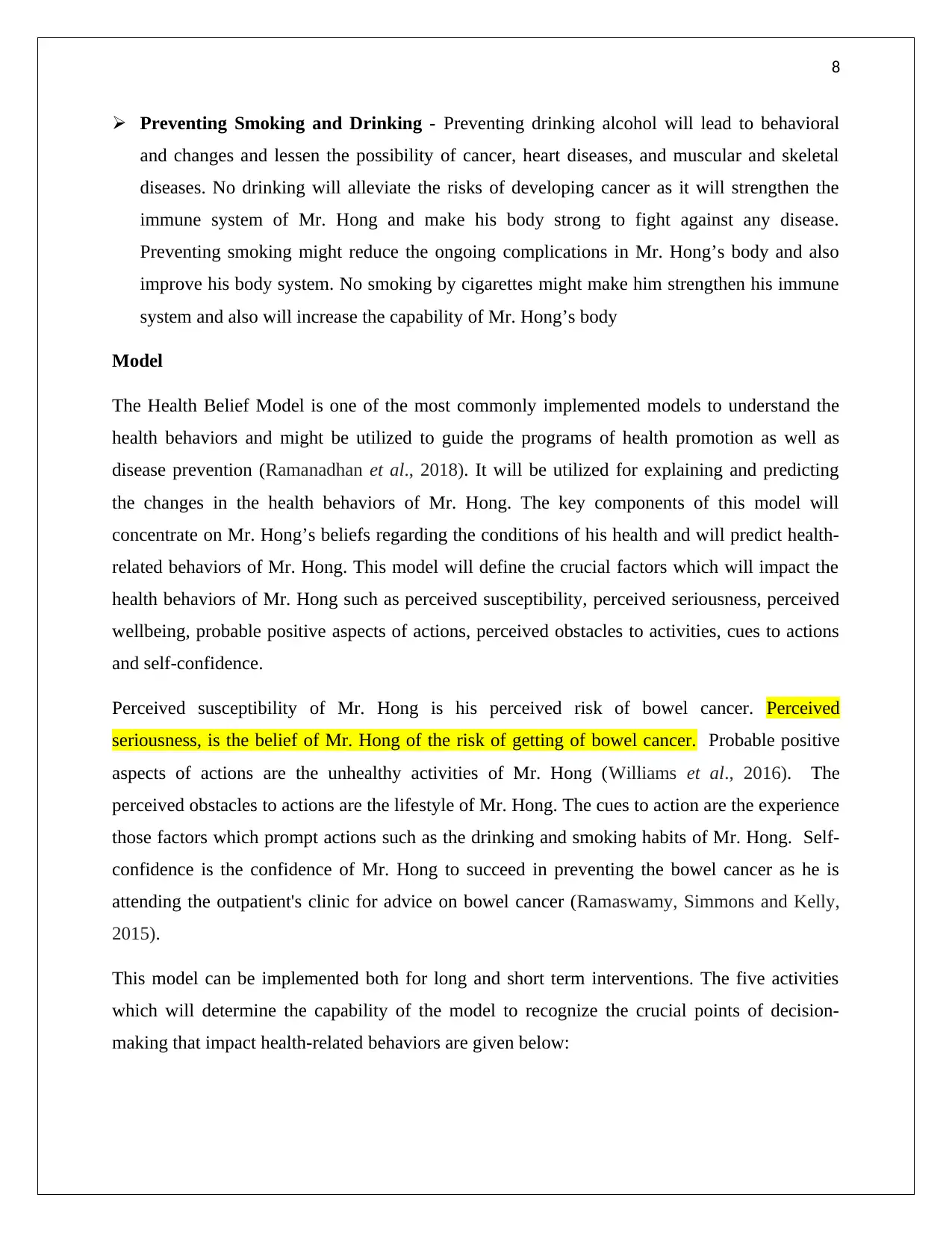
8
Preventing Smoking and Drinking - Preventing drinking alcohol will lead to behavioral
and changes and lessen the possibility of cancer, heart diseases, and muscular and skeletal
diseases. No drinking will alleviate the risks of developing cancer as it will strengthen the
immune system of Mr. Hong and make his body strong to fight against any disease.
Preventing smoking might reduce the ongoing complications in Mr. Hong’s body and also
improve his body system. No smoking by cigarettes might make him strengthen his immune
system and also will increase the capability of Mr. Hong’s body
Model
The Health Belief Model is one of the most commonly implemented models to understand the
health behaviors and might be utilized to guide the programs of health promotion as well as
disease prevention (Ramanadhan et al., 2018). It will be utilized for explaining and predicting
the changes in the health behaviors of Mr. Hong. The key components of this model will
concentrate on Mr. Hong’s beliefs regarding the conditions of his health and will predict health-
related behaviors of Mr. Hong. This model will define the crucial factors which will impact the
health behaviors of Mr. Hong such as perceived susceptibility, perceived seriousness, perceived
wellbeing, probable positive aspects of actions, perceived obstacles to activities, cues to actions
and self-confidence.
Perceived susceptibility of Mr. Hong is his perceived risk of bowel cancer. Perceived
seriousness, is the belief of Mr. Hong of the risk of getting of bowel cancer. Probable positive
aspects of actions are the unhealthy activities of Mr. Hong (Williams et al., 2016). The
perceived obstacles to actions are the lifestyle of Mr. Hong. The cues to action are the experience
those factors which prompt actions such as the drinking and smoking habits of Mr. Hong. Self-
confidence is the confidence of Mr. Hong to succeed in preventing the bowel cancer as he is
attending the outpatient's clinic for advice on bowel cancer (Ramaswamy, Simmons and Kelly,
2015).
This model can be implemented both for long and short term interventions. The five activities
which will determine the capability of the model to recognize the crucial points of decision-
making that impact health-related behaviors are given below:
Preventing Smoking and Drinking - Preventing drinking alcohol will lead to behavioral
and changes and lessen the possibility of cancer, heart diseases, and muscular and skeletal
diseases. No drinking will alleviate the risks of developing cancer as it will strengthen the
immune system of Mr. Hong and make his body strong to fight against any disease.
Preventing smoking might reduce the ongoing complications in Mr. Hong’s body and also
improve his body system. No smoking by cigarettes might make him strengthen his immune
system and also will increase the capability of Mr. Hong’s body
Model
The Health Belief Model is one of the most commonly implemented models to understand the
health behaviors and might be utilized to guide the programs of health promotion as well as
disease prevention (Ramanadhan et al., 2018). It will be utilized for explaining and predicting
the changes in the health behaviors of Mr. Hong. The key components of this model will
concentrate on Mr. Hong’s beliefs regarding the conditions of his health and will predict health-
related behaviors of Mr. Hong. This model will define the crucial factors which will impact the
health behaviors of Mr. Hong such as perceived susceptibility, perceived seriousness, perceived
wellbeing, probable positive aspects of actions, perceived obstacles to activities, cues to actions
and self-confidence.
Perceived susceptibility of Mr. Hong is his perceived risk of bowel cancer. Perceived
seriousness, is the belief of Mr. Hong of the risk of getting of bowel cancer. Probable positive
aspects of actions are the unhealthy activities of Mr. Hong (Williams et al., 2016). The
perceived obstacles to actions are the lifestyle of Mr. Hong. The cues to action are the experience
those factors which prompt actions such as the drinking and smoking habits of Mr. Hong. Self-
confidence is the confidence of Mr. Hong to succeed in preventing the bowel cancer as he is
attending the outpatient's clinic for advice on bowel cancer (Ramaswamy, Simmons and Kelly,
2015).
This model can be implemented both for long and short term interventions. The five activities
which will determine the capability of the model to recognize the crucial points of decision-
making that impact health-related behaviors are given below:
⊘ This is a preview!⊘
Do you want full access?
Subscribe today to unlock all pages.

Trusted by 1+ million students worldwide
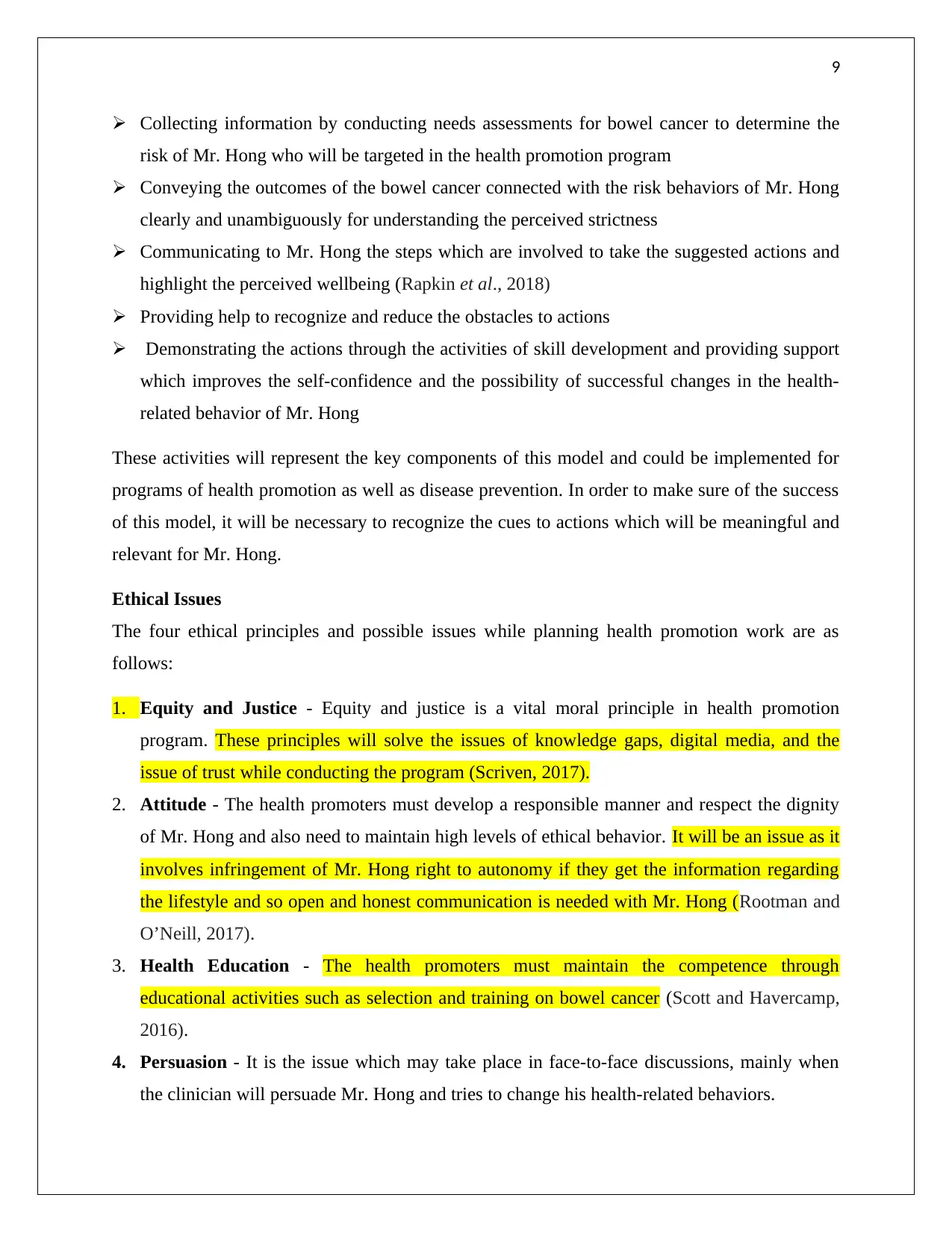
9
Collecting information by conducting needs assessments for bowel cancer to determine the
risk of Mr. Hong who will be targeted in the health promotion program
Conveying the outcomes of the bowel cancer connected with the risk behaviors of Mr. Hong
clearly and unambiguously for understanding the perceived strictness
Communicating to Mr. Hong the steps which are involved to take the suggested actions and
highlight the perceived wellbeing (Rapkin et al., 2018)
Providing help to recognize and reduce the obstacles to actions
Demonstrating the actions through the activities of skill development and providing support
which improves the self-confidence and the possibility of successful changes in the health-
related behavior of Mr. Hong
These activities will represent the key components of this model and could be implemented for
programs of health promotion as well as disease prevention. In order to make sure of the success
of this model, it will be necessary to recognize the cues to actions which will be meaningful and
relevant for Mr. Hong.
Ethical Issues
The four ethical principles and possible issues while planning health promotion work are as
follows:
1. Equity and Justice - Equity and justice is a vital moral principle in health promotion
program. These principles will solve the issues of knowledge gaps, digital media, and the
issue of trust while conducting the program (Scriven, 2017).
2. Attitude - The health promoters must develop a responsible manner and respect the dignity
of Mr. Hong and also need to maintain high levels of ethical behavior. It will be an issue as it
involves infringement of Mr. Hong right to autonomy if they get the information regarding
the lifestyle and so open and honest communication is needed with Mr. Hong (Rootman and
O’Neill, 2017).
3. Health Education - The health promoters must maintain the competence through
educational activities such as selection and training on bowel cancer (Scott and Havercamp,
2016).
4. Persuasion - It is the issue which may take place in face-to-face discussions, mainly when
the clinician will persuade Mr. Hong and tries to change his health-related behaviors.
Collecting information by conducting needs assessments for bowel cancer to determine the
risk of Mr. Hong who will be targeted in the health promotion program
Conveying the outcomes of the bowel cancer connected with the risk behaviors of Mr. Hong
clearly and unambiguously for understanding the perceived strictness
Communicating to Mr. Hong the steps which are involved to take the suggested actions and
highlight the perceived wellbeing (Rapkin et al., 2018)
Providing help to recognize and reduce the obstacles to actions
Demonstrating the actions through the activities of skill development and providing support
which improves the self-confidence and the possibility of successful changes in the health-
related behavior of Mr. Hong
These activities will represent the key components of this model and could be implemented for
programs of health promotion as well as disease prevention. In order to make sure of the success
of this model, it will be necessary to recognize the cues to actions which will be meaningful and
relevant for Mr. Hong.
Ethical Issues
The four ethical principles and possible issues while planning health promotion work are as
follows:
1. Equity and Justice - Equity and justice is a vital moral principle in health promotion
program. These principles will solve the issues of knowledge gaps, digital media, and the
issue of trust while conducting the program (Scriven, 2017).
2. Attitude - The health promoters must develop a responsible manner and respect the dignity
of Mr. Hong and also need to maintain high levels of ethical behavior. It will be an issue as it
involves infringement of Mr. Hong right to autonomy if they get the information regarding
the lifestyle and so open and honest communication is needed with Mr. Hong (Rootman and
O’Neill, 2017).
3. Health Education - The health promoters must maintain the competence through
educational activities such as selection and training on bowel cancer (Scott and Havercamp,
2016).
4. Persuasion - It is the issue which may take place in face-to-face discussions, mainly when
the clinician will persuade Mr. Hong and tries to change his health-related behaviors.
Paraphrase This Document
Need a fresh take? Get an instant paraphrase of this document with our AI Paraphraser
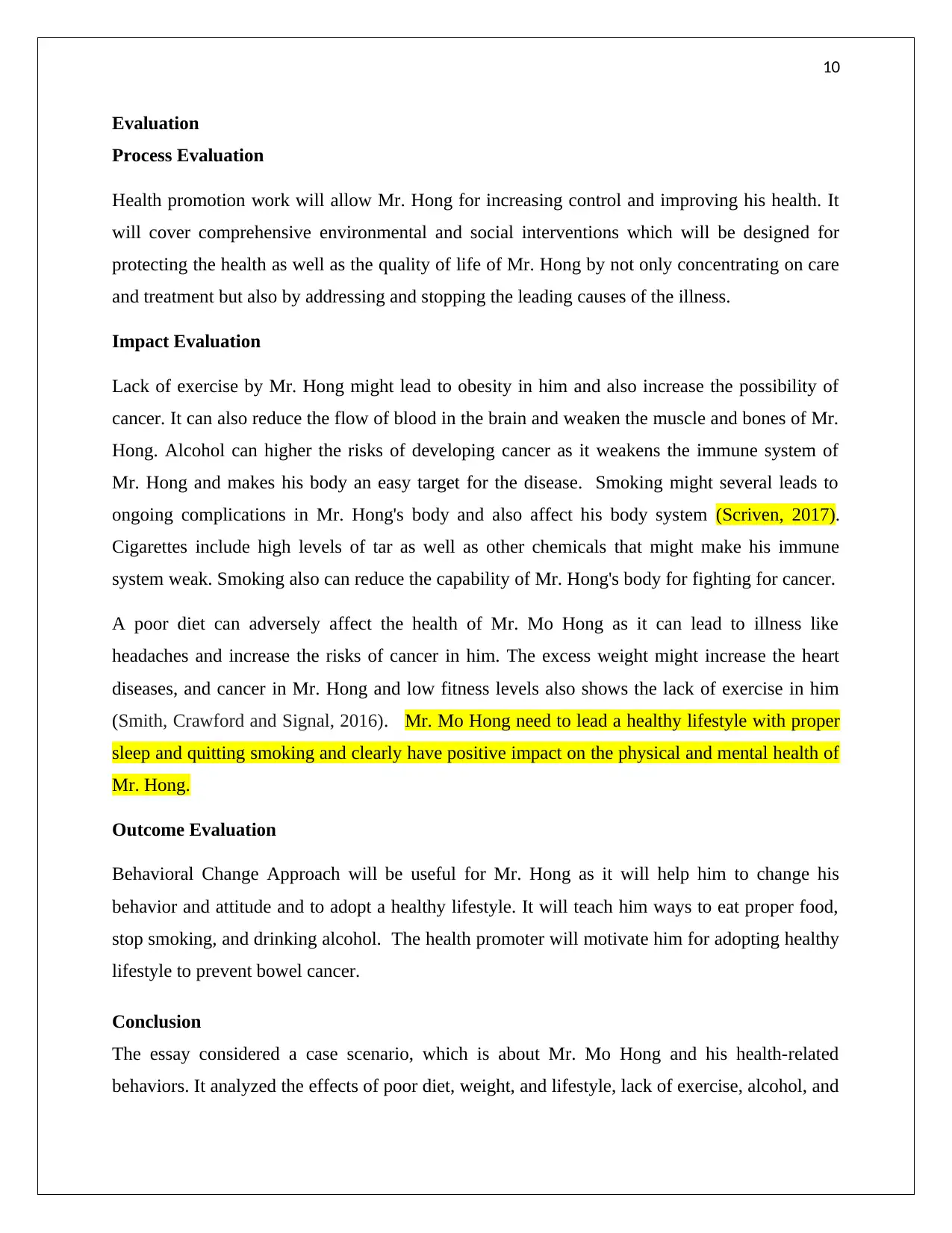
10
Evaluation
Process Evaluation
Health promotion work will allow Mr. Hong for increasing control and improving his health. It
will cover comprehensive environmental and social interventions which will be designed for
protecting the health as well as the quality of life of Mr. Hong by not only concentrating on care
and treatment but also by addressing and stopping the leading causes of the illness.
Impact Evaluation
Lack of exercise by Mr. Hong might lead to obesity in him and also increase the possibility of
cancer. It can also reduce the flow of blood in the brain and weaken the muscle and bones of Mr.
Hong. Alcohol can higher the risks of developing cancer as it weakens the immune system of
Mr. Hong and makes his body an easy target for the disease. Smoking might several leads to
ongoing complications in Mr. Hong's body and also affect his body system (Scriven, 2017).
Cigarettes include high levels of tar as well as other chemicals that might make his immune
system weak. Smoking also can reduce the capability of Mr. Hong's body for fighting for cancer.
A poor diet can adversely affect the health of Mr. Mo Hong as it can lead to illness like
headaches and increase the risks of cancer in him. The excess weight might increase the heart
diseases, and cancer in Mr. Hong and low fitness levels also shows the lack of exercise in him
(Smith, Crawford and Signal, 2016). Mr. Mo Hong need to lead a healthy lifestyle with proper
sleep and quitting smoking and clearly have positive impact on the physical and mental health of
Mr. Hong.
Outcome Evaluation
Behavioral Change Approach will be useful for Mr. Hong as it will help him to change his
behavior and attitude and to adopt a healthy lifestyle. It will teach him ways to eat proper food,
stop smoking, and drinking alcohol. The health promoter will motivate him for adopting healthy
lifestyle to prevent bowel cancer.
Conclusion
The essay considered a case scenario, which is about Mr. Mo Hong and his health-related
behaviors. It analyzed the effects of poor diet, weight, and lifestyle, lack of exercise, alcohol, and
Evaluation
Process Evaluation
Health promotion work will allow Mr. Hong for increasing control and improving his health. It
will cover comprehensive environmental and social interventions which will be designed for
protecting the health as well as the quality of life of Mr. Hong by not only concentrating on care
and treatment but also by addressing and stopping the leading causes of the illness.
Impact Evaluation
Lack of exercise by Mr. Hong might lead to obesity in him and also increase the possibility of
cancer. It can also reduce the flow of blood in the brain and weaken the muscle and bones of Mr.
Hong. Alcohol can higher the risks of developing cancer as it weakens the immune system of
Mr. Hong and makes his body an easy target for the disease. Smoking might several leads to
ongoing complications in Mr. Hong's body and also affect his body system (Scriven, 2017).
Cigarettes include high levels of tar as well as other chemicals that might make his immune
system weak. Smoking also can reduce the capability of Mr. Hong's body for fighting for cancer.
A poor diet can adversely affect the health of Mr. Mo Hong as it can lead to illness like
headaches and increase the risks of cancer in him. The excess weight might increase the heart
diseases, and cancer in Mr. Hong and low fitness levels also shows the lack of exercise in him
(Smith, Crawford and Signal, 2016). Mr. Mo Hong need to lead a healthy lifestyle with proper
sleep and quitting smoking and clearly have positive impact on the physical and mental health of
Mr. Hong.
Outcome Evaluation
Behavioral Change Approach will be useful for Mr. Hong as it will help him to change his
behavior and attitude and to adopt a healthy lifestyle. It will teach him ways to eat proper food,
stop smoking, and drinking alcohol. The health promoter will motivate him for adopting healthy
lifestyle to prevent bowel cancer.
Conclusion
The essay considered a case scenario, which is about Mr. Mo Hong and his health-related
behaviors. It analyzed the effects of poor diet, weight, and lifestyle, lack of exercise, alcohol, and
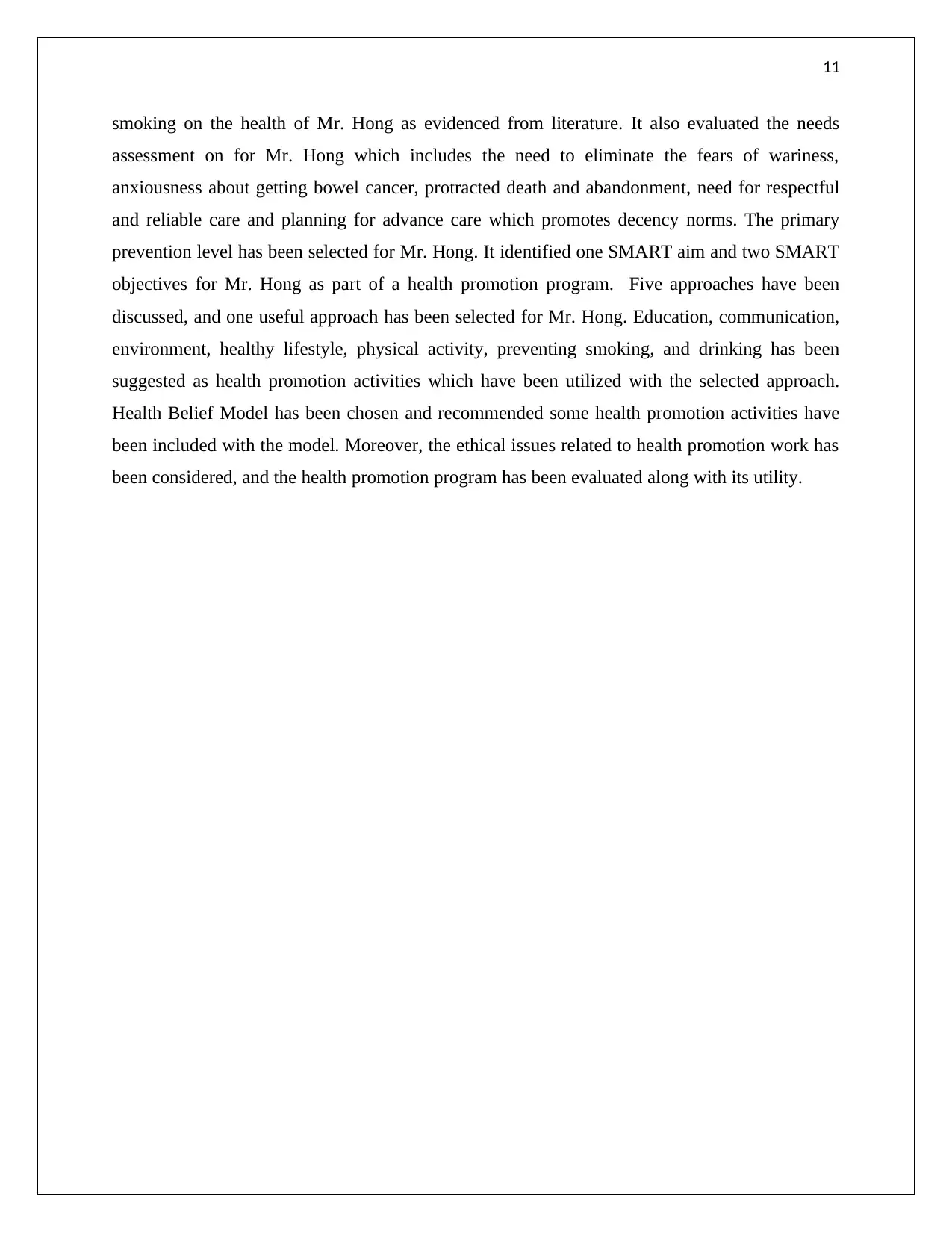
11
smoking on the health of Mr. Hong as evidenced from literature. It also evaluated the needs
assessment on for Mr. Hong which includes the need to eliminate the fears of wariness,
anxiousness about getting bowel cancer, protracted death and abandonment, need for respectful
and reliable care and planning for advance care which promotes decency norms. The primary
prevention level has been selected for Mr. Hong. It identified one SMART aim and two SMART
objectives for Mr. Hong as part of a health promotion program. Five approaches have been
discussed, and one useful approach has been selected for Mr. Hong. Education, communication,
environment, healthy lifestyle, physical activity, preventing smoking, and drinking has been
suggested as health promotion activities which have been utilized with the selected approach.
Health Belief Model has been chosen and recommended some health promotion activities have
been included with the model. Moreover, the ethical issues related to health promotion work has
been considered, and the health promotion program has been evaluated along with its utility.
smoking on the health of Mr. Hong as evidenced from literature. It also evaluated the needs
assessment on for Mr. Hong which includes the need to eliminate the fears of wariness,
anxiousness about getting bowel cancer, protracted death and abandonment, need for respectful
and reliable care and planning for advance care which promotes decency norms. The primary
prevention level has been selected for Mr. Hong. It identified one SMART aim and two SMART
objectives for Mr. Hong as part of a health promotion program. Five approaches have been
discussed, and one useful approach has been selected for Mr. Hong. Education, communication,
environment, healthy lifestyle, physical activity, preventing smoking, and drinking has been
suggested as health promotion activities which have been utilized with the selected approach.
Health Belief Model has been chosen and recommended some health promotion activities have
been included with the model. Moreover, the ethical issues related to health promotion work has
been considered, and the health promotion program has been evaluated along with its utility.
⊘ This is a preview!⊘
Do you want full access?
Subscribe today to unlock all pages.

Trusted by 1+ million students worldwide
1 out of 16
Related Documents
Your All-in-One AI-Powered Toolkit for Academic Success.
+13062052269
info@desklib.com
Available 24*7 on WhatsApp / Email
![[object Object]](/_next/static/media/star-bottom.7253800d.svg)
Unlock your academic potential
Copyright © 2020–2025 A2Z Services. All Rights Reserved. Developed and managed by ZUCOL.




